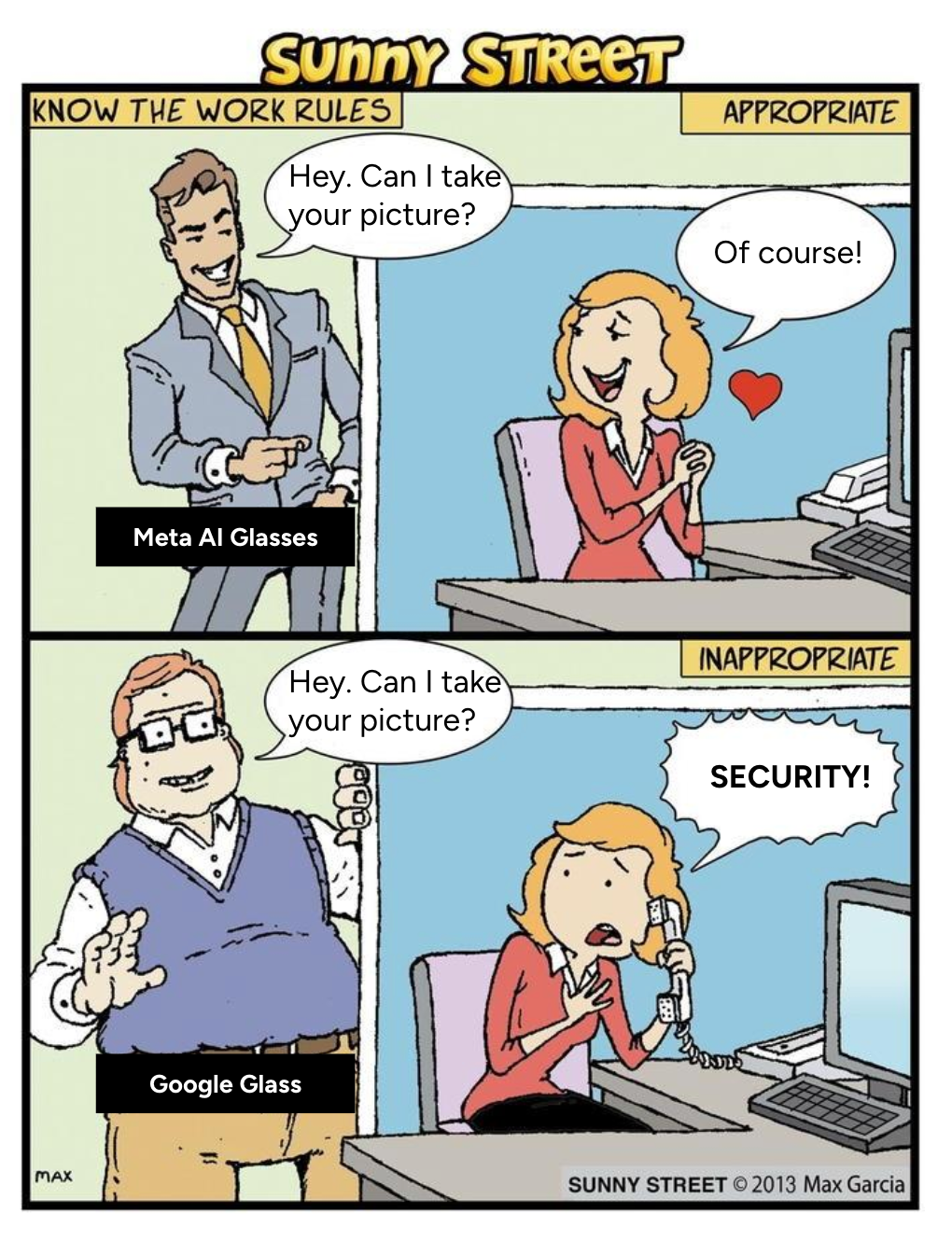Adoption of new technology often hinges less on their capability than their perception. This can be dismissed. Or this can be embraced as a universal truth. I call this dynamic "The Creepy to Cool Scale".
Every new product, whether hardware, software, or advertising, lands somewhere on this spectrum. On one end is “creepy”. Technologies that feel alien, uncanny, or imposed. On the other end is “cool”. These feel stylish, useful, or aspirational. Which side a product lands on is often the difference between being a dark stain or becoming a launching off point for new trends.

The Creepy → Cool Scale
Google Glass and Glasshole Aesthetics
Google Glass was released in 2013. My boss at the time had a pair and I remember "borrowing" it and spending hours playing "Clay Shooter". It was a game-changing bit of tech. A futuristic HUD, seamless internet access, a POV style camera. It had it all. Very Googley.
The problem is I looked like an idiot.
Scientific American's David Pogue described it as a "creepy-looking, faux-futuristic forehead band... for all I knew, it was recording me". TechCrunch's Ryan Lawler coined the term "Glasshole" in early 2013 as a reaction to the cyborg-ian look of the Silicon Valley early adopters taking to the streets wearing Glass. The camera in particular was causing concern (thanks to the ability to take a photo by winking).
Backlash came fast. Bars were quick to ban Google Glass. Wearers were heckled. Technology that Larry & Sergey thought would launch us into the future felt more like corporate sponsored surveillance and stalled.
Zuck Made Surveillance Cool
A decade later, Meta partnered with Ray-Ban to release smart glasses that have an embedded POV camera, audio recordings, seamless internet connectivity. Sound familiar? Google Glass, just a decade later and a new coat of paint.
This time, however, reception could not have been more different.
NY Mag's The Strategist described them as “much better than I expected... these glasses don’t look too different from standard Ray-Bans.” Digital Trends called them “the best everyday smartglasses we’ve tried.” Even Oprah added them to her list of favorite things.
Either Google was ahead of its time technologically, the surveillance state became the norm, or people just wanted to look cool all along. The technology had not dramatically changed, but the perception had. What was once creepy was now cool.
Advertising and What We're Willing to Accept
Digital advertising is another great landscape to plot out on the Creepy -> Cool scale. One that I know well having spent my career in marketing. Fingerprinting is identifying users without their concent by stitching together device data. It's creepy. It's also very effective. When this practice became popularized it caused massive backlash and regulatory scrutiny (GDPR, CCPA, etc).
Contrast fingerprinting to simple personalized advertising and the latter is often welcomed. Most people complain about ads, but few really object to their relevance (outside of the "TikTok is listening to my conversations" trope). The difference between seeing an ad about hiking boots instead of lingerie is not about capability but about perception. One feels helpful and the other feels invasive.
Clippy, Face ID, and Everyday Algorithms
Microsoft's Clippy was, in retrospect, a brutish attempt at AI assistance. It was annoying, unwanted, and intrusive. It is so iconically bad that it became a meme. 26 years later, conversational AI like ChatGPT completely reframed the assistant role. No googly eyes and no interruptions. There when you needed it and invisible when you don't. Same idea of “assistant,” but one felt creepy, the other feels essential.
Facial recognition initially suffered from similar suspicion to that of fingerprinting. Then Apple released Face ID with the iPhone X and facial recognition normalized within months. Now people even buy hotdogs with just their faces. Same capability. One just looked cooler.
When algorithmic drive political ads led to the Cambridge Analytica outrage, Spotify's Discovery Weekly recommendations are beloved. Very similar tech. Different reactions. One is creepy. The other is cool.
The Structure of the Scale
Where something falls on the Creepy -> Cool scale is composed of three different variables:
- Design & Vibes: Does the product make users and those around the users feel aspirational or alien?
- Google Glass looked like science-fiction. Meta AI Ray-Bans are fashion.
- Transparency: Is the trade off clear and fair?
- Fingerprinting was hidden, personalized ads are visible.
- Readiness: Is society ready for this behavior?
- Cameras everywhere in 1995 scared people. Cameras everywhere in 2025 is ordinary.
Where a new product falls emerges from the answers to these questions. Technologies that weave the three are considered cool. Those that fail, even at one, are creepy.
The Law of Creepy → Cool
Perception functions as a filter. Capabilities that emerge from the filter as creepy tend to stall, regardless of technical merit. Capabilities that emerge as cool spread quickly, regardless of complexity.
This is why Glass failed while Ray-Ban succeeded, why fingerprinting faced regulation while personalization persisted, why cartoon assistants like Clippy were mocked while AI assistants like ChatGPT are beloved.
What’s the Implication
The Creepy → Cool Scale shows that many apparent “failures of technology” were not failures of engineering or quality, but failures of perception. Google Glass was not technologically premature. In fact it was ahead of its time. It was, however, socially premature. Fingerprinting was not a technical dead end; it was a publicly one once exposed (don’t be fooled, many businesses are still in this dirty business).
The scale explains how behaviors once strange can become completely ordinary. Talking to AirPods, engaging in commerce with your face, broadcasting to strangers on TikTok — all might have seemed eerie before they became a part of every day life.
The lesson is less about what companies should do than about how markets evolve. Adoption is not determined solely by what is possible but by what is palatable.
Closing Thoughts
Identical words. Opposite reactions. But the technology is no different.

The Creepy → Cool Scale Explained in Meme
Everything lands somewhere on the Creepy → Cool Scale. If you don’t know where you fall, I have bad news for you.
